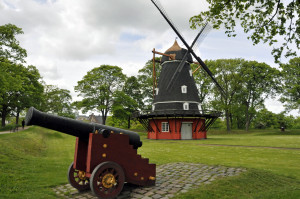
Windmill and Cannon in Kastellet (Photo by Don Knebel)
In 1626, Danish King Christian IV began building Kastellet to defend the harbor north of Copenhagen. The fortress took the form of a five-pointed star, surrounded by a moat. Bastions at each point allowed cannons to fire in all directions. To enable defenders to weather a siege, the fortress included 16 windmills for grinding flour and a Baroque style church where troops could pray.
In 1725, King Frederick IV built a prison behind the church, with eye holes in the cell walls so inmates could follow the church proceedings. The most famous prisoner was Johann Friedrich Struensee, a German physician to schizophrenic King Christian VII who became an important governmental reformer in his own right. Following discovery of Struensee’s affair with King Christian’s young Queen, he was held in Kastellet’s prison in 1772 until he was beheaded, quartered and displayed in pieces a few blocks away in what is now a lovely park.
Today, Kastellet houses branches of the Danish military, including the intelligence service. Colorful barracks sit amid the grassy ramparts and a lone Danish soldier stands guard at the guard house. Cannons point toward ancient foes. But the entire property is freely open to thepublic, with concerts held regularly on the manicured grounds and in the church. On the fourth Friday after Easter, Danes parade atop Kastellet’s ramparts in spring finery celebrating Store Bededag (“Great Prayer Day”), a religious holiday introduced by the Church of Denmark in 1686 to consolidate several minor feast days. Every October 28, the last surviving windmill, erected in 1847, is tested to assure that it remains capable of feeding besieged troops. So far, so good.
Comments are closed.